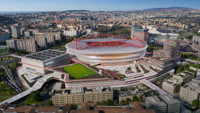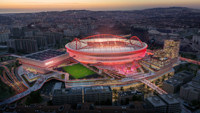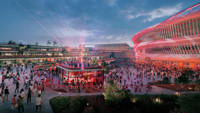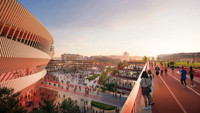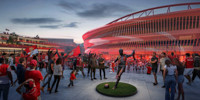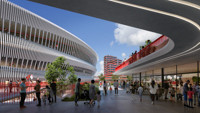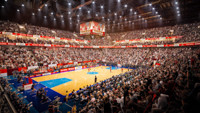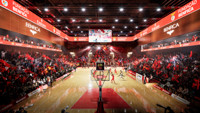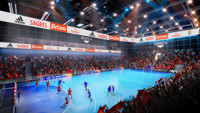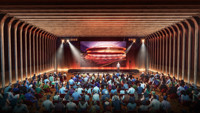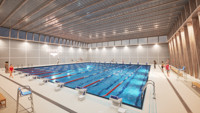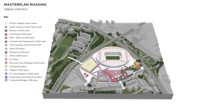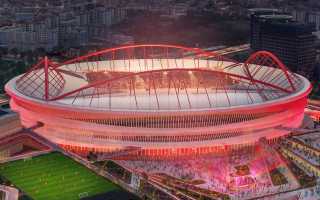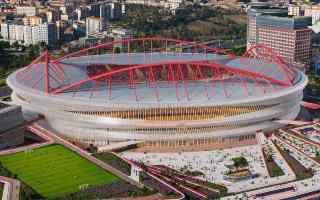Benfica District
| Capacity | 70 000 |
|---|---|
| Country | Portugal |
| City | Lisbon |
| Clubs | SL Benfica |
| Category | Design awaiting implementation |
| Cost | €220 M ($258 M) |
| Construction | 2026–2030 |
| Design | Populous, Saraiva + Associados |
Advertisement
Benfica District – design description
What is the Benfica District project about?
The Benfica District project focuses on the area surrounding Estádio da Luz, which is set to undergo a complete transformation. The development includes a new multi-purpose indoor arena with a capacity of 10,000 spectators, along with two smaller sports halls, a swimming pool, a new club museum and store, a hotel, and other commercial facilities.
A large plaza is planned in front of the stadium’s east facade. It is designed to become an attractive public space, a meeting point for fans, and a venue for various events.
The stadium itself will also see some changes. Its exterior will be enhanced with a striking new facade, giving it a more modern and dynamic look, while the interior will gain additional usable space. As part of the works, the seating capacity is expected to increase to 70,000, with a possible future expansion to 80,000.
Through this investment, Benfica aims not only to strengthen its position as one of the country’s leading sports clubs, but also to better prepare the stadium for the 2030 FIFA World Cup.
What is Estádio da Luz like?
Estádio da Luz is the largest stadium in Portugal and home to the country’s most decorated football club, SL Benfica. The venue was built in 2002–2003, just ahead of UEFA Euro 2004, right next to the previous stadium of the same name, which served the club since 1954.
The stadium can accommodate 68,100 spectators and is known for its distinctive architecture, featuring elegantly curved stands and impressive roof-supporting arches.
What work has been carried out at Estádio da Luz in recent years?
Since 2022, the stadium has undergone a series of minor renovations aimed at improving its appearance, enhancing spectator comfort, and elevating the matchday experience. Among the upgrades were new, larger video screens, LED boards along the edges of the stands, improved sound systems, and dynamic event lighting.
How has the capacity of Estádio da Luz increased recently?
In the summer of 2024, an additional row of seats was installed on the first tier, increasing the stadium’s capacity by 950 to a total of 66,000. In December 2024, Benfica president Rui Costa announced plans to further expand the capacity to reach 70,000 seats.
In the summer of 2025, seating capacity was increased to 68,100 by adding extra rows to the lower part of the stands along the pitch. The target of 70,000 is expected to be reached within the next two years.
When was the Benfica District project announced?
The Benfica District project was officially presented on July 22, 2025. The ceremony at Estádio da Luz was attended by Lisbon’s mayor, Carlos Moedas, and the Minister of Culture, Youth and Sports, Margarida Balseiro Lopes.
FIFA President Gianni Infantino also congratulated Benfica via a pre-recorded video message, wishing the club success with the project and expressing hope that it will help better prepare the stadium for the 2030 World Cup.
The concept was designed by the renowned international architecture firm Populous – the same studio that designed the current Estádio da Luz over two decades ago. The Benfica District vision was developed in collaboration with local practice Saraiva + Associados.
What are the key features of the Benfica District project?
The Benfica District focuses less on the stadium itself and more on a large-scale transformation of the area to its east. Existing facilities near the stadium, such as the sports halls and club museum, will be demolished and the land will be completely redeveloped.
The plan includes the construction of entirely new facilities in this area, including:
- a large multi-purpose arena with a capacity of 10,000 spectators
- two smaller arenas seating 2,500 and 1,500 people, respectively
- a 25×25 m swimming pool open to the local community
- a 500-seat theatre and event hall
- residential and commercial buildings, restaurants, and shops
- a hotel with 120 rooms and 100 apartments intended for athlete accommodation
- a new club museum and store
- a recreated academy pitch to be built on the roof of the two smaller sports halls, surrounded by running track–like paths
- a large public square in front of the stadium’s east façade
The new square in front of the east façade is intended to revitalize an area that has so far been largely occupied by parking lots, transforming it into an attractive public space, a meeting place for fans, and a venue for various events. The design of the square is inspired by Praça do Rossio and other plazas found throughout Lisbon.
The square will feature, among other things, a stage for a DJ as well as a relocated statue of the legendary Eusébio. It will be surrounded by shops and restaurants, including the club store and the new Benfica museum.
How will Estádio da Luz change thanks to the Benfica District project?
The stadium itself will also undergo some significant changes. The exterior will be covered with slats that will create an attractive facade, giving it a more modern and dynamic appearance. The facade will be equipped with LED lighting, enabling spectacular animations to be displayed.
Inside, a fourth floor of facilities will be added, providing 6,800 m² of usable space with offices, commercial areas, and hospitality zones. The renderings also show a panoramic screen along the upper tier, similar to the one at the stadium in Krasnodar.
How will the capacity of Estádio da Luz change during the Benfica District project?
The Benfica District project does not directly address changes in the stadium’s capacity; however, the club is proceeding with the previously announced increase to 70,000 seats. In summer 2025, additional lower rows raised the capacity by over 2,000 seats, reaching 68,100. The 70,000 mark is expected to be reached within the following two years.
Furthermore, during the presentation of the Benfica District project, club president Rui Costa announced that Benfica is already working on a possible increase in seating capacity to 80,000.
What significance will the implementation of the Benfica District project have?
The project’s implementation should strengthen Benfica’s position as one of the country’s leading sports clubs – thanks to the new halls, the non-football sections will also benefit from improved conditions.
The new facade and attractively developed space around the stadium will improve the overall image of the venue, potentially enhancing the club’s brand perception. Additionally, commercial functions will help generate higher revenues.
By including a large hall for 10,000 spectators, the complex stands to become an important sports and entertainment center with considerable national importance and international recognition. The investment will also help properly prepare the stadium for the 2030 World Cup, during which it is expected to host, among other matches, one of the semi-finals.
It is worth adding that at the time of the Benfica District project presentation, Estádio José Alvalade – the stadium of Benfica’s derby rival Sporting, located about 3 km away – was also undergoing modernization. Estádio José Alvalade is also scheduled to host matches during the 2030 World Cup.
When will the Benfica District project be completed?
The club expects the first construction works to begin in early 2026. The planned duration of the investment is four years, aiming for the facility to be ready before the 2030 FIFA World Cup.
However, the club hopes that the work, at least on the stadium itself, can be finished earlier—especially if Portugal is awarded the hosting rights for the 2029 Women's European Championship.
How much will the Benfica District project cost?
The cost of the Benfica District project is estimated at €220 million. The entire cost will be covered by the club itself, and according to the adopted financing model (Project Finance), the investment is expected to be repaid within 15 years from generated revenues. Benfica also hopes to secure a stadium naming rights sponsor.
How could the club's presidential election affect the Benfica District project?
The Benfica presidential election is scheduled for October 25, 2025. The current president, Rui Costa, will run for re-election, but shortly before the Benfica District project presentation, the former president Luís Filipe Vieira, who served in this role for nearly 18 years (2003–2021), also announced his candidacy.
Luís Filipe Vieira has presented his own vision called “Cidade do Benfica”, according to which the club should build a completely new stadium with a capacity of 120,000 spectators (this was the capacity of the old Estádio da Luz in the late 1980s and early 1990s, when it was the largest stadium in Europe). Therefore, if Vieira wins the October 2025 election, the Benfica District plans may be subject to revision.
Advertisement

 StadiumDB
StadiumDB